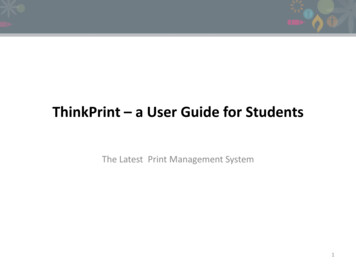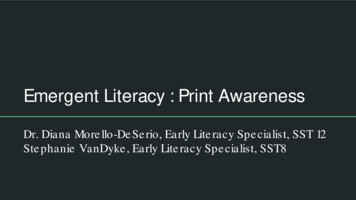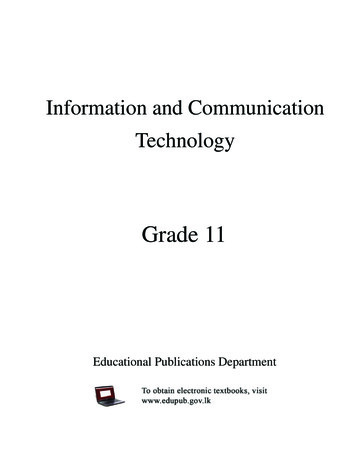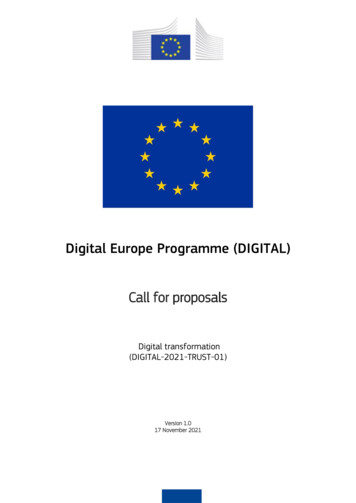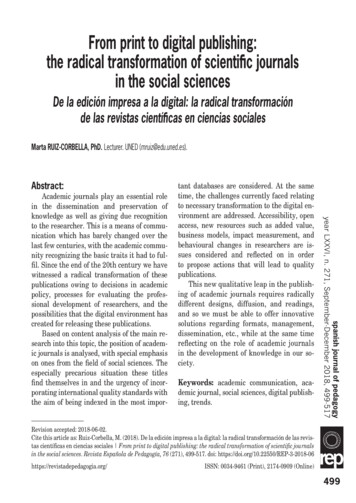
Transcription
From print to digital publishing:the radical transformation of scientific journalsin the social sciencesDe la edición impresa a la digital: la radical transformaciónde las revistas científicas en ciencias socialesMarta RUIZ-CORBELLA, PhD. Lecturer. UNED (mruiz@edu.uned.es).Abstract:Keywords: academic communication, aca demic journal, social sciences, digital publish ing, trends.spanish journal of pedagogyyear LXXVI, n. 271, September-December 2018, 499-517Academic journals play an essential rolein the dissemination and preservation ofknowledge as well as giving due recognitionto the researcher. This is a means of commu nication which has barely changed over thelast few centuries, with the academic commu nity recognizing the basic traits it had to ful fil. Since the end of the 20th century we havewitnessed a radical transformation of thesepublications owing to decisions in acade micpolicy, processes for evaluating the profes sional development of researchers, and thepossibilities that the digital environment hascreated for releasing these publications.Based on content analysis of the main re search into this topic, the position of academ ic journals is analysed, with special emphasison ones from the field of social sciences. Theespecially precarious situation these titlesfind themselves in and the urgency of incor porating international quality standards withthe aim of being indexed in the most impor tant databases are considered. At the sametime, the challenges currently faced relatingto necessary transformation to the digital en vironment are addressed. Accessibility, openaccess, new resources such as added value,business models, impact measurement, andbehavioural changes in researchers are is sues considered and reflected on in orderto propose actions that will lead to qualitypublications.This new qualitative leap in the publish ing of academic journals requires radicallydifferent designs, diffusion, and readings,and so we must be able to offer innovativesolutions regarding formats, management,dissemination, etc., while at the same timereflecting on the role of academic journalsin the development of knowledge in our so ciety.Revision accepted: 2018-06-02.Cite this article as: Ruiz-Corbella, M. (2018). De la edición impresa a la digital: la radical transformación de las revis tas científicas en ciencias sociales From print to digital publishing: the radical transformation of scientific journalsin the social sciences. Revista Española de Pedagogía, 76 (271), 499-517. doi: stadepedagogia.org/ISSN: 0034-9461 (Print), 2174-0909 (Online)499
Marta RUIZ-CORBELLAspanish journal of pedagogyyear LXXVI, n. 271, September-December 2018, 499-517Resumen:500Las revistas científicas cumplen una fun ción esencial en la difusión y preservación dela ciencia, además de otorgar reconocimientoal investigador. Es un medio de comunicaciónque ha permanecido con escasas modificacio nes a lo largo de los últimos siglos, recono ciéndose en la comunidad científica los rasgosbásicos que debía cumplir. Ahora bien, desdefinales del siglo XX estamos viviendo una ra dical transformación de estas publicacionesdebido a las decisiones en política de la cien cia, a los procesos de evaluación del desarrolloprofesional de los investigadores y a las posi bilidades que ha generado el entorno digital ala edición de estas publicaciones.A partir del análisis de contenido de lasprincipales investigaciones sobre esta temáti ca, se aborda el estudio de la situación de lasrevistas científicas, con especial incidencia enlas del campo de las ciencias sociales. Se reco ge la especial precariedad en la que se encuen tran estos títulos y la urgencia de incorporarlos estándares internacionales de calidad con1. IntroductionWriting about academic journalsmeans writing about science. They ap peared over 350 years ago as a channel foracademic communication, cumulativelysetting down in writing advances in eachfield of knowledge. They still remain anunrivalled means of disseminating theresults of research under the maximthat anything that is not published doesnot exist (Delgado López-Cózar & RuizPérez, 2009). In this context, since theirvery beginnings, periodical publicationshave become an undisputed point of ref erence for the academic community asel objetivo de ser indexadas en las bases dedatos más relevantes. A su vez, se acometenlos retos que están planteándose en la actua lidad para afrontar la necesaria transforma ción al entorno digital. La accesibilidad, elacceso abierto, los nuevos recursos como valorañadido, los modelos de negocio, las medicióndel impacto o los cambios de comportamientoen los investigadores son cuestiones que sonpresentadas para generar la reflexión y la pro puesta de acciones que nos lleven a publicacio nes de calidad.Este nuevo salto cualitativo en la ediciónde revistas científicas está exigiendo diseños,difusión y lecturas radicalmente diferentes,por lo que debemos ser capaces de aportarsoluciones innovadoras en formatos, gestión,difusión, etc., a la vez que reflexionar sobre lafunción de las revistas científicas en el desa rrollo de la ciencia en nuestra sociedad.Descriptores: comunicación científica, revis tas científicas, ciencias sociales, edición digi tal, tendencias.they provide visibility, reliability, uni versality, and recognition (Alonso-Gam boa, 2017). In other words, they not onlydisseminate the results of research butalso facilitate mechanisms for recordingauthors, ensuring the quality of sub missions, and preserving them, so thatknowledge can continue to be construct ed based on them (Ware & Mabe, 2015).The review of submissions by experts,the presentation of texts in a definedformat, their periodical distribution byspecialist publishers (scientific societies,universities, etc.) are the elements thathave characterised every journal, with
From print to digital publishing: the radical transformation of scientific journals However, we are now in a situationwhere it is clear that the academic journalwill soon no longer take the form it cur rently has. While the way they were pub lished was virtually unchanged for nearlyfour centuries, the last 40 years have seena spectacular evolution shaped by tech nology which is changing the entire struc ture and organisation of these academicpublications (Gu & Blackmore, 2016). Theintroduction of the standardised criterianeeded to guarantee the transfer and re trieval of academic information, the gen eralisation of journal evaluation systems,the appearance of information and com munication technology (ICT) in the fieldof research and documentation, and soon, are radically changing academic com munication, while at the same time pro moting the commitment to open research(European Commission, 2016). It is alsoimportant to bear in mind that a decisivefactor in the importance currently givento any academic journal is a result of thepolitical decision to make them a signifi cant part of the processes for evaluatingthe scientific and academic careers of re searchers, something which has createdan unprecedented demand to publish injournals with a high impact factor (Ware& Mabe, 2015).This transformation affects all aca demic journals, regardless of their sub ject area, imposing changes on theirstructure, organisation, and publicationthat were until now unthinkable. How ever, if we focus on the field of socialsciences, it becomes apparent that thesejournals have not developed at the samepace as ones from other areas thanks tothis field’s particular way of carryingout research characterised by heteroge neous methodologies, practices, ways ofdisseminating findings, and recognitionderived from these publications (Abadal,2017). This subject has titles that arewell recognised and have a long tradi tion, but which until the 1990s did notundertake the necessary adaptation tonormalised quality standards and atten tion to international trends in the aca demic community. It is a sector that stillmaintains many of the traditions andfeatures of its past and, despite beingpresent online, still largely maintainsthe structure and format of the printededition (Abadal, 2017).spanish journal of pedagogyyear LXXVI, n. 271, September-December 2018, 499-517a structure and organisation that havebeen maintained over time (Laakso,2017). Undertaking this type of projectrequired enthusiasm and an interest inpromoting one’s own publication, whilealso having a means of academic com munication as documentary proof of theresearch activity of the institution itself,and a network of scientific collaborationcapable of facilitating this whole processwas activated (Corera-Álvarez & MolinaMolina, 2016). Over all these years, cri teria for assessing quality were not re quired of this type of publication, andso editorial teams limited themselves tocomplying with certain standards rec ognised by the community, publishingthe promised volume, and distributingit to university libraries, scientific insti tutions, and subscribers. In this context,the recognition of the journals dependedon the reputation of the editors and/orthe institutions that funded them.At the same time, there is no doubtthat scientific activity in Spain has501
Marta RUIZ-CORBELLAdeveloped extraordinarily over the last20 years, leading to significant changesin researchers’ behaviour and a notableincrease in scientific productivity and vis ibility (IUNE, 2016). In this context, jour nals become a vital part in the processas the main medium for disseminatingresearch, as they are recognised as themain indicator for professional recogni tion and progression, reinforcing the publish or perish attitude that shapes everyresearcher’s work.spanish journal of pedagogyyear LXXVI, n. 271, September-December 2018, 499-5172. Academic journals: towards anecessary transformation502Examining the quality of academicjournals is something that has interest ed experts in scientific documentationfor over 50 years. From the middle ofthe 20th century onwards, a number ofinternational bodies, such as UNESCO(1963) and the International Federationfor Documentation (1963), national insti tutions, experts, and so on, implementedprojects aimed at establishing policies toidentify and promote the best academ ic journals to guarantee the dissemina tion of the knowledge generated. Thiswas the origin of the implementation ofevaluation processes (Delgado LópezCózar & Ruiz Pérez, 2009). At the sametime, scientific information managersappeared that were capable of interre lating bibliographic information andinfor mation analysis resources to eval uate and analyse the performance ofresearch (Web of Science and Scopus).Databases and catalogues were created(Latindex, REDALyC, SciELO, MIAR,etc.) that drew up quality criteria aimedat selecting the best publications. Weshould not forget that we are discussing agalaxy of 68,819 active academic journalsaround the world (Navas, 2017), a morethan sufficient number to cover the out put of researchers. Nonetheless, it wasgovernmental and institutional policiesthat dictated that publications had to beindexed in one or other of the two mostimportant databases if they were to beregarded as being of quality: the Web ofScience (WoS) database by ClarivateAnalytics (USA) and the Scopus data base by Elsevier (the Netherlands). Asa result, these became reference pointsfor the quality of all research (Martínez& Moreno, 2016). In this way, the verydynamic of academic work and the recog nition of scientific and academic institu tions, researchers, and policy managersled to WoS, ahead of Scopus and otherproducts, becoming the leading point ofreference for evaluating academic work,based particularly on the «fact that theimpact factor established itself as themain indicator for evaluating articles»(Borrego, 2017, p. 26).Nonetheless, examining what jour nals are indexed in the two databas es shows that they currently only list47.6% of publications at a global level(Graph 1): 15.23% in WoS and 32.37% inScopus. This is a clearly insufficient lev el of representation and one which has avery uneven distribution between sub ject areas. The over-representation ofthe sciences and engineering, journals inEnglish, and journals from certain west ern countries in WoS is clear. And if weanalyse the presence of the social sci ences in both databases, the percentage
From print to digital publishing: the radical transformation of scientific journals falls to 15.89% in WoS and 32.37% inScopus for indexed journals, putting thissubject area in a deeply unequal compet itive position.Graph 1. Number of journals indexed in WoS and Scopus.Source: Navas, 2017.as a result shapes the behaviour of theacademic community. There is no ques tion that these two large bibliographicinformation companies have become «themain instruments of control of scientificproduction and for evaluating research ers» (Delgado López-Cózar & Ruiz-Pérez,2009, p. 27).Table 1. World ranking of journals and presence (in %) in JCR and Scopus.World rankingCountriesTotal no. ofjournals%% in JCR% 7%18.68%7%10Spain1,7202.5%5.81%3%spanish journal of pedagogyyear LXXVI, n. 271, September-December 2018, 499-517But the idea is clear: either a journalis in WoS it is not recognised since thevalue of each journal is identified withbeing indexed in this platform (Table 1)(Alperin & Rozemblum, 2017). This crite rion shapes academic output, the careerprogress of researchers, and even re search funding (Ware & Mabe, 2015) andSource: Adapted from Navas, 2017.503
Marta RUIZ-CORBELLAThis action framework was what in spired academic journals from the fieldof social sciences to adapt urgently to theestablished quality parameters. Whilethe sciences already had recognised inter national criteria for disseminating andrecognising research, the social sciencesdid not concern themselves with theserequirements for many years, as can beseen from each field’s research output(Table 2).Table 2. Production of academic articles by fieldin the Spanish university system 2006-2015.spanish journal of pedagogyyear LXXVI, n. 271, September-December 2018, 499-517Academic fieldSciences236,401Health sciences114,470Engineering and architecture108,176Social and legal sciences44,241Arts and humanities24,393Source: Adapted from IUNE 2017.If we consider the situation in Spain,no journals are currently ignoring thesequality criteria for evaluating researchoutput as they aim to be included in thedatabases the academic world regardsas reference points. This is driving thisradical transformation in social sciencepublications. Here we are talking about33.7% of journals, compared with 27.2%from the field of sciences. The social sci ence journals have a local focus in con tent, organisation, and publishing, whilescience journals are designed with a clearinternational dimension (Claudio, MartínBaranera, & Villarroya, 2017).It should not be forgotten that the or igins of academic journals in the socialsciences were linked to academic organ isations, either university institutions orresearch institutions that did not aim to504Production of documentsmake a profit from them. Their interestwas not in making a profit but insteadin there being bodies to publicise the ad vances in their research, something thatwould lead to academic prestige and rec ognition from the academic communi ty (Delgado López-Cózar & Ruiz-Perez,2009). These bodies continue to run thesepublications, although commercial pub lishers for which profit and professional isation are the primer concerns are grad ually entering the field. This situation isalready well-established outside Spainwith well-established companies in thissector such as Taylor & Francis, Elsevier,Springer, and Wiley, among others (Di estro, Ruiz-Corbella, & Galán, 2017;Navas, 2017), causing a change in modelin the organisation of these publications(Graph 2).
From print to digital publishing: the radical transformation of scientific journals Graph 2. Distribution of bodies owning academic journals in Spain.Source: Adapted from Claudio, Martín Baranera, & Villarroya Planas, 2017.As publishers we are, paraphrasingthe famous saying, well aware that weoperate in an inside or perish model thatobliges us to be alert to trends that shapethe development of these publications. Inaddition,we should not forget that creating andmaintaining academic and professionaljournals is a key instrument in the organi sation, structuring, and social institution alisation of areas of knowledge, as thesepublications are a constituent element ofthe production and reproduction of knowhow (Delgado López-Cózar, 2017, p. 74).Accordingly, academic journals haveplayed and are playing a key role in re search, not just as part of the research pro cess as a channel for disseminating discov eries and results, but also as a mechanismfor recognising authors, with all of the im plications this has for them.At the same time, these policies for eval uating research have meant that the meansof publication increasingly look the sameacross different fields, with a significant im pact on the behaviour of researchers and,by extension, academic work in each area(choice of topic, methodologies, formats forcommunication, etc.).Neither should we ignore the fact thatthis is an industry that is consolidated atan international level, had a turnover ofmore than 25 billion dollars in 2013 withprojected annual growth of 4%, and hasvery good prospects for growth in theopen access environment (Ware & Mabe,2015). This fact raises the debate aboutspanish journal of pedagogyyear LXXVI, n. 271, September-December 2018, 499-517These graphs lead us to consider howprecarious the field of social sciences inSpain is, despite its large number of ac tive journals, thanks to the late adoptionof international standards, its deep root ed local focus, and the fact that 57.21%of the bodies that publish these journalsare public institutions affected by polit ical and economic vagaries (annual lim its, human resources restrictions, etc.),meaning that university publishing hasworse results than publishing from othersectors (Corera-Álvarez & MolinaMolina, 2016).505
spanish journal of pedagogyyear LXXVI, n. 271, September-December 2018, 499-517Marta RUIZ-CORBELLA506the influence of these publications on theacademic world, about the importance ofpolicy decisions in this field, and aboutthe institutions that publish them.(Alonso-Gamboa, 2017). However, in mostcases they limited themselves to makingthe printed journal available in an onlinesetting, thus increasing dissemination ina process with no turning back.3. The challenge of publishing indigital settingsFrom 2010, there was a qualitativeleap with the spread of web 2.0, whichprovides applications aimed at enrichingcontent and interaction between publish ers, authors, and users. Digital publish ing consequently opens up a new model inwhich resources that facilitate the recov ery of information, collaboration, the useof different communications channels,interaction, the inclusion of social mediaand so on are conspicuous. The great pos sibilities this setting offers are graduallyleading all journals to abandon the printformat and publish online exclusively.Shifting to online publishing is no longerjust an option, but rather a need: if youare not online, you do not exist (Fiala &Diamandis, 2017). This is more than justa change; it is a radical transformation ofhow the academic journal is understood,of how people publish in it, disseminateits content, and measure its impact. Inconsequence, it is important to analysethe factors that make this new paradigmpossible.In the academic world, and in partic ular the academic publications createdby it, the appearance of ITC has had adecisive impact on researchers’ movetowards ways of behaving that differradically from the ones they tradition ally adopted. These technologies pro vide ever more powerful resources forstudying and analysing large amountsof data, they make research possible inpreviously unthinkable fields, and theycan retrieve and process data quicklyregardless of physical location. Thesenew possibilities are creating changesboth in how research is done and how itis disseminated and evaluated (Fiala &Diamandis, 2017).The turning point for change of modeloccurred in the 1990s when the first elec tronic scientific publications started toappear (Ruiz-Corbella, Galán, & Diestro,2014; Alonso-Gamboa, 2017). In Spain, inthe field of education, the Revista Electrónica de Investigación y EvaluaciónEducativa (RELIEVE) in 1994 becamethe first open-access electronic publica tion, albeit with many reservations fromcolleagues. Gradually, as the potentialof the internet became apparent, on line spaces were created where journalscould host content, with the proportionof journals taking advantage of this in creasing from 2% in 1997 to 33% in 20173.1. AccessibilityThe digital format is the key to facili tating access to content without any costfor users. Content can be accessed fromany device, along with resources that areincluded to add value to the research, andso scientific content is no longer limitedto a physical format. The result of thisis that each journal moves closer to the
From print to digital publishing: the radical transformation of scientific journals researchers as it is present in their placeof work (Ruiz-Corbella y Galán, 2017),in databases, in social media, and in thedigital settings where they interact. Weemphasise social media as they are prov ing their strength of interaction and theircapacity to boost visibility. Consequently,it is necessary to plan the online presenceof each publication and its content, some thing which requires new specialismsin each editorial team (Ruiz-Corbella,Galan, & Diestro, 2014), as well as involv ing authors in disseminating in their owndigital spaces.3.3. Open accessThe Open Access movement, whichsince 2002 has encouraged universal ac cessibility and licenses to reuse scientificdocuments, guaranteesall users a free, irrevocable, worldwide,right of access to, and a license to copy,use, distribute, transmit and display thework publicly and to make and distributederivative works, in any digital mediumfor any responsible purpose (Open AccessInitiative, 2003).This movement is driving two majorchanges. On the one hand, there is the de cisive influence on the access and dissem ination in research policies, promotingthe compulsory requirement to deposit inopen access all data produced by publiclyfunded research, as well as the publica tions and documents deriving from it. Theaim is that all of them will be availablefor free by 2020 (European Commission,2016). The argument behind this is that ifwork has been publicly funded, every citi zen should have the right to access it, andit should be made more visible. The de bate goes on, but the fact is that researchfunding is already awarded under theseconditions, and projects like SciELO(1998), PLOS (2000), and DOAJ (2003)were pioneers in this policy (GERECS,2018). Repositories to store any documentspanish journal of pedagogyyear LXXVI, n. 271, September-December 2018, 499-5173.2. New resources as added valueAnother aspect that is still not ful ly developed in these publications is theenrichment the digital environment of fers. Designing pages that not only con tain content in text format, but are alsoenriched with different complementa ry options (audio, video, graphics, data,hyperlinks, interactivity, etc.), to facil itate the digital experience. Being ableto interact with authors, other readers,contributing your own critique of eacharticle, accessing complementary mate rial, and such like opens up new waysof accessing, appraising, and evaluatingresearch that ensure great interactivity.This requires a change in how articles arepublished and accessed as well as howthey are read, altering the one-way com munication that, until now, shaped therelationship between authors and readers(Cruces, 2017). Offering a «live» text thatprovides not just the process and resultsof research but also, and in different for mats, everything needed to give a comple mentary perspective to the one set out init. In this way, the author’s collaborationwith the journal does not end when thearticle is published but instead involves amajor commitment, not just to enrichingthe research presented but also to inter acting with other colleagues who take aninterest in it.507
Marta RUIZ-CORBELLAcreated, open publishing of academicjournals, and the appearance of new copy right models like Creative Commons areexamples of the new models of workingin this digital setting, which mean thatat present 63.5% of scientific productionis available openly in its different forms(Graph 3).spanish journal of pedagogyyear LXXVI, n. 271, September-December 2018, 499-517Graph 3. Percentage of articles published in the different types of open access.508Source: Adapted from Corera-Álvarez and Molina-Molina, 2016.3.4. Business modelsFree access is not free from costs,something which is encouraging newbusiness models as the costs of institu tional subscriptions are moved onto au thors through payments for publishing(Bjork, 2017). The idea is thatif access is to be free, and if the jour nals, however digital they may be, havea cost (and they undoubtedly do), it islogical to look for an alternative fundingstream and that this is payment of pub lishing costs by the authors (Anglada,2017, p. 110).The cost of publishing each article(the article processing charges or APC) ispassed on to the author, a practice that isalready established among journals in theEnglish-speaking world, especially in thefield of sciences, which charge between1000 and 2000 pounds, with notable dif ferences between different journals andpublishing groups, and with very few set ting their charges below these amounts(Research Information Network, 2015).This payment is based on the costs of ed iting, peer review, number of pages, use ofcolour in the printed version, etc. The dif ferences in APCs between journals leadus to ask whether there is a need to iden tify the real costs of publishing to avoidabuse and fraud, especially to the detri ment of authors who do not have the sup port of established research groups. Whilewe argue that academic journals shouldnot be a profit-making business, we doagree that they must have enough incometo cover the cost of quality publishing ina digital context, income that must also,
From print to digital publishing: the radical transformation of scientific journals little by little, facilitate the professionali sation of editorial teams.This process of inclusion in inter national databases and the growingvalue of publications in journals that areindexed and have impact for researchers’CVs have transformed the publishingscene and affected the management of thejournals, which need a growing degreeof professionalism to survive (MartínezMoreno, 2008, p. 316).The fierce competition to position andmake visible each publication is graduallyresulting in major multinationals under taking this publishing and so transform ing the world of publishing.In addition, the need for the journalto increase its visibility in the scientif ic community, as well as its reputationcomprising its brand and digital identity,Another consequence of the digital for mat is the inclusion of digital identifiersfor the journal and for all of its content.The complexity of the internet and theenormous quantity of data that accumu late support the need for each documentto have its own identifier (Digital ObjectIdentifier-DOI) to guarantee its conser vation and recovery independently of anyupheavals that happen to each journal’swebsite. This very interesting ability topreserve each document and retrieve itthrough key words as well as the DOIis undoubtedly having an impact on thetrend towards the article being more im portant than the journal, of the unit overthe collective.3.6. Scientific impactSince the middle of the twentieth cen tury, as mentioned above, systems havebeen implemented to evaluate the quali ty of journals. Among the various initia tives, two international businesses standspanish journal of pedagogyyear LXXVI, n. 271, September-December 2018, 499-5173.5. Managing and publishing journalsOne issue, derived from the previousone, focuses on management, publica tion, and dissemination models. Thesepublications were originally funded andsponsored by academic societies, uni versities, and/or institutions that pro moted research, and were, on the whole,managed by a director/editor who un dertook much of the editorial manage ment. However, this management nowrequires input from teams comprising avariety of professionals who are expertsin digital publishing, editorial manage ment, scientific documentation, etc.,and so it is unlikely that a single editorwould be able to perform all of the rolesrequired.means it is disseminated through socialmedia. If with the printed edition, dis semination focussed on sending copies tolibraries, institutions, and authors, whoin turn spread it around their contacts,with digital editions, this action is donejointly by the editorial team and authors.Ensuring each article is present in data bases, directories, social media, etc., giv ing added value to the published content,placing it in the spaces where researchnetworks converge, etc., are key to en suring the impact of each article. Thesetasks involve real editorial marketing de sign and the confluence of different spe cialists.509
spanish journal of pedagogyyear LXXVI, n. 271, September-December 2018, 499-517Marta RUIZ-CORBELLA510out: Web of Science (WoS) by ClarivateAnalytics (USA), a scientific informationplatform that provides tools to evaluatethe quality of publications, and Scopusby Elsevier (the Netherlands), the larg est database of scientific production. Bothprovide diffe
From print to digital publishing: the radical transformation of scientific journals 501 spanish journal of pedagogy year L, n. , eptember ecember , a structure and organisation that have been maintained over time (Laakso, 2017). Undertaking this type of project required enthusiasm
